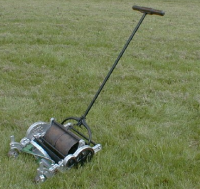








A lawn mower is a machine that uses one or more revolving blades to cut a lawn to an even height. The blades may be powered either by hand; pushing the mower forward to operate the mechanical blade(s), or may have an electric motor or an internal combustion engine to spin their blades. Some mowers also include other abilities, like mulching or collecting their clippings.
Two main styles of blades are used in lawn mowers. Lawn mowers employing a single blade that rotates about a single vertical axis are known as rotary mowers, while those employing a multiple blade assembly that rotates about a single horizontal axis are known as cylinder or reel mowers.
There are several types of mowers, each suited to a particular scale and purpose. The smallest types are pushed by a human user and are suitable for small residential lawns and gardens. Riding mowers are larger than push mowers and are suitable for large lawns. The largest multi-gang mowers are mounted to tractors and are designed for large expanses of grass such as golf courses and municipal parks.
A transition from traditional hand-guided or ride-on mowers to automatic electric mowers is beginning to take place, with the growth in robotic lawn mower sales of 2012 being 15 times the growth in sales of the traditional styles.At current rates of growth automated lawn mowers are set to soon reach the point of outselling traditional mowers in some regions.
Invention
The first lawn mower was invented by Edwin Budding in 1830 in Thrupp, just outside Stroud, in Gloucestershire, England. Budding's mower was designed primarily to cut the grass on sports grounds and extensive gardens, as a superior alternative to the scythe, and was granted a British patent on August 31, 1830.
Budding's first machine was 19 inches (480 mm) wide with a frame made of wrought iron. The mower was pushed from behind. Cast iron gear wheels transmitted power from the rear roller to the cutting cylinder, allowing the rear roller to drive the knives on the cutting cylinder; the ratio was 16:1. Another roller placed between the cutting cylinder and the main or land roller could be raised or lowered to alter the height of cut. The grass clippings were hurled forward into a tray-like box. It was soon realized, however, that an extra handle was needed in front to help pull the machine along.Overall, these machines were remarkably similar to modern mowers.
Two of the earliest Budding machines sold went to Regent's Park Zoological Gardens in London and the Oxford Colleges.In an agreement between John Ferrabee and Edwin Budding dated May 18, 1830, Ferrabee paid the costs of enlarging the small blades, obtained letters of patent and acquired rights to manufacture, sell and license other manufacturers in the production of lawn mowers. Without patent, Budding and Ferrabee were shrewd enough to allow other companies to build copies of their mower under license, the most successful of these being Ransomes of Ipswich, which began making mowers as early as 1832.
His machine was the catalyst for the preparation of modern-style sporting ovals, playing fields (pitches), grass courts, etc. This led to the codification of modern rules for many sports, including for football, lawn bowls, lawn tennis and others.